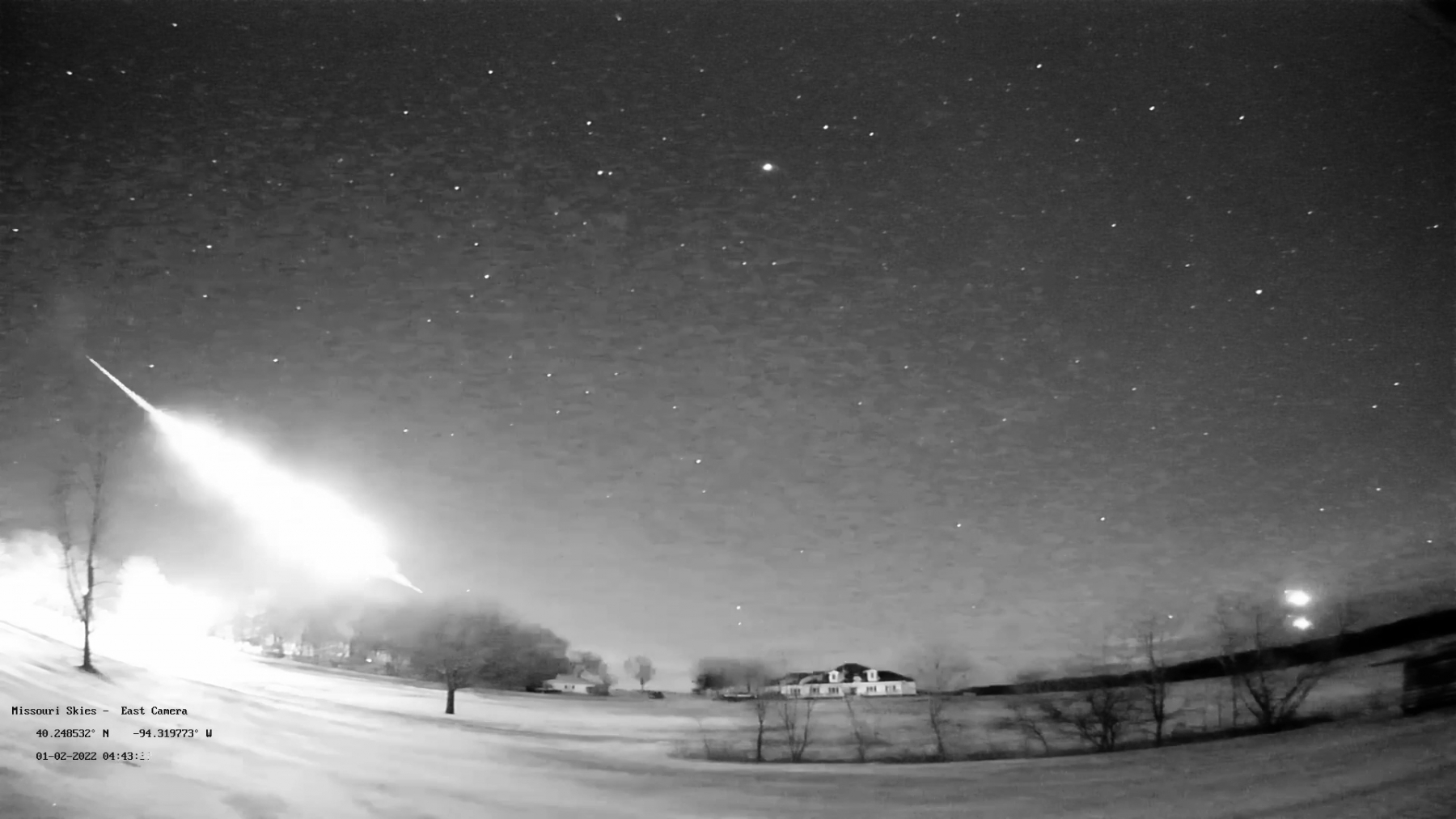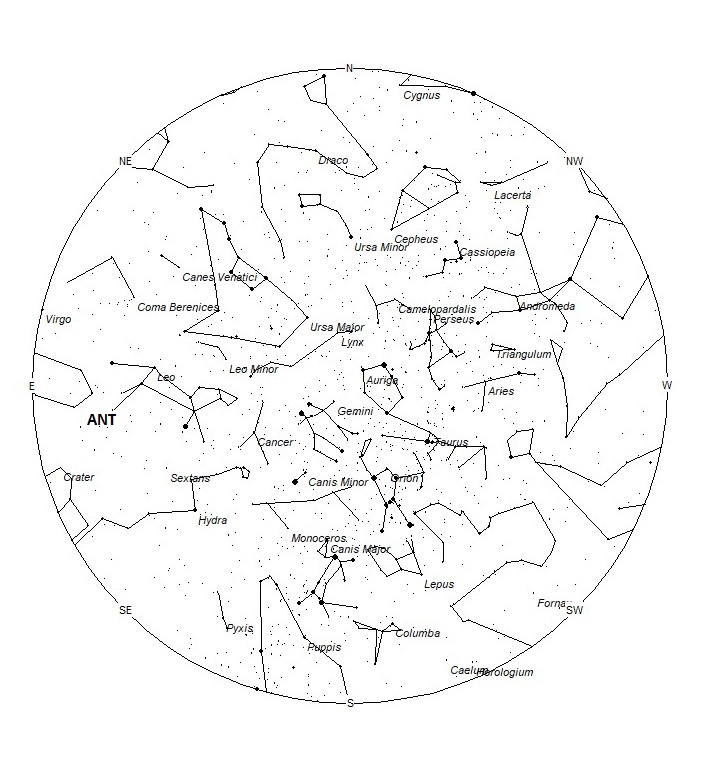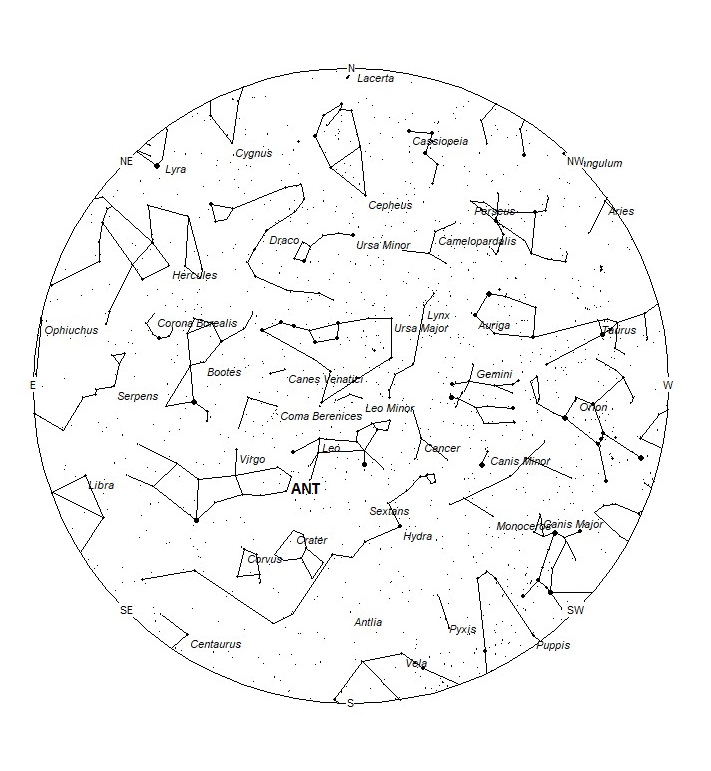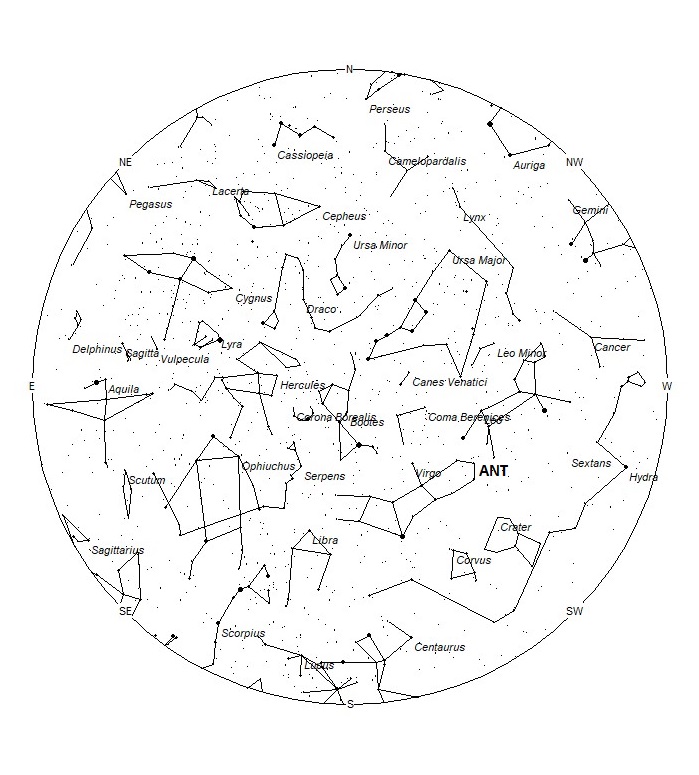
As seen from the northern hemisphere, March is the slowest month of the year for meteor activity. No major annual showers are active and only a few very weak minor showers produce activity this month. The sporadic rates are also near their annual minimum so there is not much to look forward to this month except for the evening fireballs that seem to peak this time of year. This could be due to the fact the Antapex radiant lies highest above the horizon this time of year during the evening hours as seen from the Northern Hemisphere. From the Southern Hemisphere, activity from the Centaurid complex begins to wane with only the weak activity visible from Norma and perhaps others nearby areas. At least southern sporadic rates are still strong to make the late summer viewing a bit more pleasurable.
During this period, the moon reaches its new phase on Wednesday March 2nd. At that time the moon lies near the sun and is invisible at night. This weekend the waning crescent moon will rise during the early morning hours but will not interfere with meteor observing as long as you keep it out of your field of view. For evening observers, the estimated total hourly rates should be near 2 as seen from mid-northern latitudes (45N) and 3 as seen from tropical southern locations (25S) For morning observers, the estimated total hourly rates should be near 5 as seen from mid-northern latitudes (45N) and 10 as seen from tropical southern locations (25S). The actual rates will also depend on factors such as personal light and motion perception, local weather conditions, alertness, and experience in watching meteor activity. Note that the hourly rates listed below are estimates as viewed from dark sky sites away from urban light sources. Observers viewing from urban areas will see less activity as only the brighter meteors will be visible from such locations.
The radiant (the area of the sky where meteors appear to shoot from) positions and rates listed below are exact for Saturday night/Sunday morning February 26/27. These positions do not change greatly day to day so the listed coordinates may be used during this entire period. Most star atlases (available at science stores and planetariums) will provide maps with grid lines of the celestial coordinates so that you may find out exactly where these positions are located in the sky. I have also included charts of the sky that display the radiant positions for evening, midnight, and morning. The center of each chart is the sky directly overhead at the appropriate hour. These charts are oriented for facing south but can be used for any direction by rotating the charts to the desired direction. A planisphere or computer planetarium program is also useful in showing the sky at any time of night on any date of the year. Activity from each radiant is best seen when it is positioned highest in the sky, either due north or south along the meridian, depending on your latitude. It must be remembered that meteor activity is rarely seen at the radiant position. Rather they shoot outwards from the radiant, so it is best to center your field of view so that the radiant lies at the edge and not the center. Viewing there will allow you to easily trace the path of each meteor back to the radiant (if it is a shower member) or in another direction if it is sporadic. Meteor activity is not seen from radiants that are located far below the horizon. The positions below are listed in a west to east manner in order of right ascension (celestial longitude). The positions listed first are located further west therefore are accessible earlier in the night while those listed further down the list rise later in the night.
These sources of meteoric activity are expected to be active this week.
The beta Tucanids (BTU) produced an outburst last year on March 12th. This was unexpected as activity of around one per night is more common for this display. If the outburst re-occurs again in 2022, it should occur on a 20-hour time frame centered on 6:00 Universal Time on March 13. Early members of this shower may appear as early as 2 March, but rates would be extremely low. On the night of March 12/13, the radiant is located at 04:07 (062) -77. The current location should not be much different due to the high southern declination. This area of the sky is located in western Mensa, two degrees southeast of the 3rd magnitude star known as gamma Hydri. These meteors are best seen as soon as it becomes dark in the deep Southern Hemisphere. They are not visible from the Northern Hemisphere. With an entry velocity of 31 km/sec., these meteors would be of slow velocity. Don’t confuse these meteors with the delta Mensids, which become active a bit later in March and peak near 21 March.
The large Anthelion (ANT) is currently centered at 11:24 (171) +04. This position lies in southeastern Leo, 2 degrees south of the 4th magnitude star known as sigma Leonis. Due to the large size of this radiant, these meteors may also be seen from western Virgo as well as Leo. This radiant is best placed near 01:00 local standard time (LST) when it lies on the meridian and is highest in the sky. Rates at this time should be near 2 per hour no matter your location. With an entry velocity of 30 km/sec., the average Anthelion meteor would be of slow velocity.
As seen from the mid-northern hemisphere (45N) one would expect to see approximately 4 sporadic meteors per hour during the last hour before dawn as seen from rural observing sites. Evening rates would be near 2 per hour. As seen from the tropical southern latitudes (25S), morning rates would be near 9 per hour as seen from rural observing sites and 3 per hour during the evening hours. Locations between these two extremes would see activity between the listed figures.
You can keep track of the activity of these meteor showers as well as those beyond the limits of visual observing by visiting the NASA Meteor Shower Portal available at: https://meteorshowers.seti.org/ You can move the sky globe to see different areas of the sky. Colored dots indicate shower meteors while white dots indicate sporadic (random) activity. The large orange disk indicates the position of the sun so little activity will be seen in that area of the sky.
| SHOWER | DATE OF MAXIMUM ACTIVITY | CELESTIAL POSITION | ENTRY VELOCITY | CULMINATION | HOURLY RATE | CLASS |
| RA (RA in Deg.) DEC | Km/Sec | Local Standard Time | North-South | |||
| beta Tucanids (BTU) | Mar 13 | 04:07 (062) -77 | 31 | 18:00 | <1 – <1 | III |
| Anthelions (ANT) | — | 11:24 (171) +04 | 30 | 01:00 | 2 – 2 | II |
 American Meteor Society
American Meteor Society


